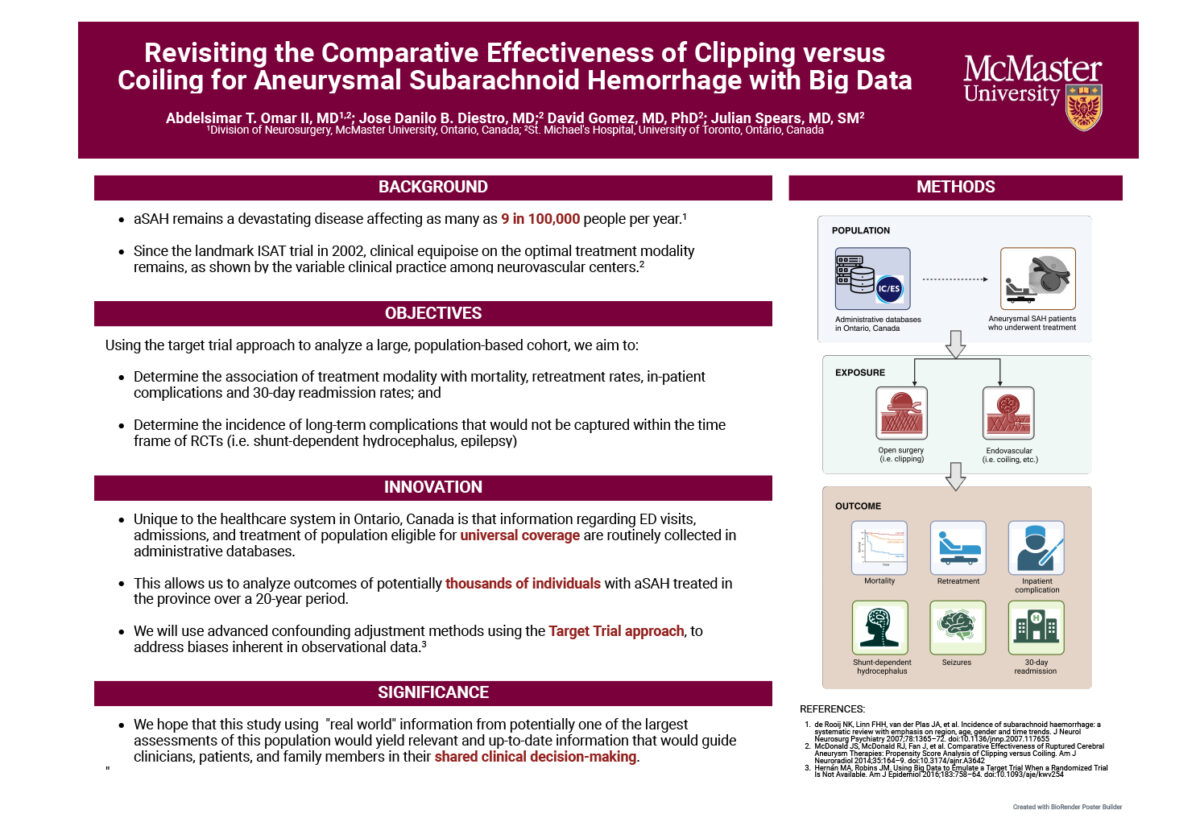Meet Research Grant Recipient: Abdelsimar T. Omar II, MD

Dr. Abdelsimar T. Omar is the recipient of the Running Against Ruptures Chair of Research for $30,000.
BAF: Please tell us your background, where you are from, schooling, etc.
AO: I am currently an Assistant Professor of Neurosurgery at McMaster University and staff neurosurgeon at the Hamilton General Hospital in Ontario, Canada. I completed my medical and neurosurgical training at the University of the Philippines – Philippine General Hospital. I then pursued subspecialty training in Skull Base Surgery at the University of Calgary – Foothills Medical Centre, followed by a clinical fellowship in Neuro-oncology at the University of Toronto – St. Michael’s Hospital. I am currently completing the Master of Science in Epidemiology program at the Harvard T.H. Chan School of Public Health.
My research interest lies in leveraging administrative databases in health services and surgical outcomes research. In particular, I am involved in work emulating landmark trials in neurosurgery using administrative databases, including the comparative effectiveness of treatment options for intracranial aneurysms.
BAF: What led you to become involved with brain aneurysm research?
AO: I have treated and operated on patients with ruptured intracranial aneurysms and understand first-hand the complexities of clinical decision-making in this population. Landmark randomized controlled trials on comparative effectiveness have been done, yet the variability in practice patterns across the world reveals that some equipoise still remains. I was interested in applying advanced methods of confounding adjustment I learned in my epidemiologic training, to “emulate” RCTs using observational data we have available in Ontario. This will allow us to use updated “real world” data on comparative effectiveness that be valuable for physicians, patients, and their families in their shared clinical decision-making.
BAF: In the simplest terms, what is the purpose of your project?
AO: Our study wishes to revisit the question of which treatment is “best” for patients with ruptured aneurysms by “emulating” the landmark International Subarachnoid Aneurysm Trial (ISAT) using “real world” data. Unique to the healthcare system in Ontario is that information regarding emergency department visits, hospital admissions, and treatment of the population eligible for universal health coverage is routinely collected in administrative databases. This allows us to analyze the outcomes of potentially thousands of individuals with ruptured aneurysms treated in Ontario over a 25-year period. We will compare the relative effectiveness of surgical clipping and endovascular coiling and look at outcomes such as death, complication rates during hospitalization, and the need for repeat treatment. We will also look at the effect of treatment on complications that develop over a longer term, which may not be captured in randomized trials. These include hydrocephalus and seizures, among others.
BAF: In the simplest terms, what do you hope will change through your research findings?
AO: We hope that the results of our study using “real world” information from potentially one of the largest populations of patients who suffered from ruptured aneurysms will yield relevant information regarding the comparative effectiveness of treatment strategies for aneurysmal subarachnoid hemorrhage. We hope our study helps guide clinicians, patients, and their families in their shared clinical decision-making.
BAF: Why is the funding you are receiving through the Brain Aneurysm Foundation so important?
AO: The funding received from the Brain Aneurysm Foundation will be invaluable for our project as we aim to use the grant to cover direct costs. These include fees paid to research personnel working at ICES, a non-profit research institute based in Toronto, Canada where the linked health administrative databases for the province of Ontario are housed.
Pictured above is Dr. Omar’s research poster, “Revisiting the Comparative Effectiveness of Clipping versus Coiling for Aneurysmal Subarachnoid Hemorrhage with Big Data”


 Brain Aneurysm Foundation
Brain Aneurysm Foundation 